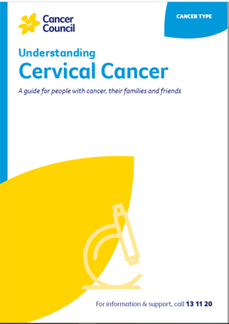- Home
- Cervical cancer
- Screening
Screening for cervical cancer
Screening is organised testing to find precancer before it develops into cancer, as well as early cancers before symptoms appear. The cervical screening test – which has replaced the Pap test – finds cancer-causing types of HPV in cell samples taken from the cervix.
Learn more about:
The National Cervical Screening Program
The National Cervical Screening Program recommends that women start cervical screening at age 25 and then have a test every 5 years. A final test is recommended between ages 70 and 74. All people with a cervix need regular screening. There are 2 ways to collect cells for a cervical screening test. In most cases, you can choose the way you prefer.
Health provider collected
During the test, a doctor or nurse gently inserts an instrument (called a speculum) into the vagina to widen the vaginal walls and get a clearer view of the cervix. They will then use a brush or spatula to remove some cells from the cervix. This can feel slightly uncomfortable, but usually takes only 1–2 minutes.
The cell sample is then placed in a container of liquid and sent to a laboratory to check for HPV. If HPV is found, a specialist doctor called a pathologist will do an additional test on the sample to check for cell abnormalities. This is called liquid-based cytology (LBC).
Self-collected
This is done in a private space (e.g. a bathroom) in a health clinic. A health care provider will give you a self-collection swab and explain how to collect your own cell sample. Or, if you prefer, the provider can assist you to collect the sample without using a speculum. Self-collection is only available to people who do not have any signs or symptoms of cancer. Self-collected samples are not suitable for liquid-based cytology, so if HPV is detected, you may be asked to return to have a health provider collect a second sample or be referred for a colposcopy.
The test results are used to predict your level of risk for significant cervical changes. If the results show:
- a higher risk – you will be referred for a colposcopy
- an intermediate risk – you will be monitored with a follow-up screening test in 12 months
- a low risk (no HPV detected) – you will be due for your next cervical screening test in 5 years.
For more information, call Cancer Council 13 11 20 or visit cervicalscreening.org.au.
What are precancerous cervical cell changes?
Sometimes the squamous cells and glandular cells in the cervix start to change, and appear abnormal when viewed under a microscope. These early cervical cell changes may be precancerous. This means there is an area of abnormal tissue (a lesion) that is not cancer, but may lead to cancer.
Some people with precancerous changes of the cervix will develop cervical cancer, so it is important to investigate any cervical cell changes.
How precancerous cell changes start
Precancerous cervical cell changes are caused by some types of the human papillomavirus (HPV). The latest evidence suggests that all squamous cell cancers and about 9 out of 10 adenocarcinomas are caused by HPV.
HPV and cervical cell changes don’t usually cause symptoms but can be found during a routine cervical screening test.
There are 2 main types of cervical cells that can have precancerous changes – squamous cells and glandular cells.
Abnormal squamous cells
Previously called cervical intraepithelial neoplasia (CIN), these are now called squamous intraepithelial lesions (SIL). They can be classified as either low grade (LSIL) or high grade (HSIL), depending on how abnormal the cells are and how deep they are in the surface of the cervix.
LSIL usually disappear without treatment, while HSIL can be precancerous. High-grade abnormalities have the potential to develop into early cervical cancer if they are not found and treated.
Abnormal glandular cells
High-grade precancer in glandular cells is called adenocarcinoma in situ (AIS or ACIS). AIS is not cancer, but needs treatment to reduce the chance that it develops into adenocarcinoma.
Treating cervical cell changes
Finding and treating precancerous cervical cell changes will prevent them developing into cervical cancer. Read more about how precancerous cervical cell changes are treated.
Learn more about the Cervical Screening Test.
→ READ MORE: Cervical cancer diagnosis
Podcast for people affected by cancer
Listen now
More resources
Prof Martin Oehler, Director of Gynaecological Oncology, Royal Adelaide Hospital, and Clinical Professor, University of Adelaide, SA; Dawn Bedwell, 13 11 20 Consultant, Cancer Council QLD; Gemma Busuttil, Radiation Therapist, Crown Princess Mary Cancer Centre, Westmead Hospital, NSW; Dr Antonia Jones, Gynaecological Oncologist, The Royal Women’s Hospital and Mercy Hospital for Women, VIC; Angela Keating, Senior Psychologist, Royal Hospital for Women, NSW; Anne Mellon, Clinical Nurse Consultant – Gynaecological Oncology, Hunter New England Centre for Gynaecological Cancer, NSW; Dr Inger Olesen, Medical Oncologist, Andrew Love Cancer Centre, Barwon Health, Geelong, VIC; Dr Serena Sia, Radiation Oncologist, Fiona Stanley Hospital and King Edward Memorial Hospital, WA; A/Prof Megan Smith, Co-lead, Cervical Cancer and HPV Stream, The Daffodil Centre, Cancer Council NSW and The University of Sydney, NSW; Emily Stevens, Gynaecology Oncology Nurse Coordinator, Southern Adelaide Local Health Network, Flinders Medical Centre, SA; Melissa Whalen, Consumer.
View the Cancer Council NSW editorial policy.
View all publications or call 13 11 20 for free printed copies.



